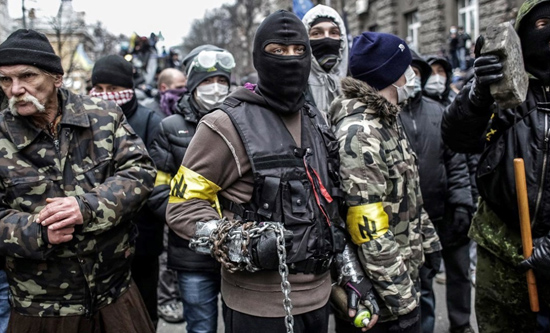
The term ‘revolution’ has perhaps never been misused as frequently in the mainstream media as over the past few years. No longer does it refer to a vast social upheaval of the oppressed and exploited masses against a (usually US-backed) oppressive regime. Instead it is now used routinely to describe movements funded by US government agencies to replace governments which have fallen into disfavour with US puppets. The so-called Maidan revolution (deriving its name from the central square in Kiev where its supporters held their rallies) fits the bill perfectly. Although the Ukrainian president Viktor Yanukovich had been democratically elected, he suffered from a fatal flaw. His wing of the bourgeoisie tried to perform a balancing act between Russia and the European Union (EU), while the opposition was intent on bringing Ukraine firmly into the orbit of the EU – and of the US, including NATO membership if possible. Neither this reality, nor the involvement of the fascist Svoboda party, did anything to dim the enthusiasm of petit bourgeois leftists in Western Europe for this odious enterprise – even as the US National Endowment Fund for Democracy (sic) poured funds into it.
On the night of 21 February 2014, Yanukovich fled to Russia as the Maidan’s armed gangs took over Kiev, where a new, distinctly right-wing government was installed, including a sizeable fascist contingent. Soon World War II-era Nazi-collaborators had statues erected in their honour in public squares. Plans were made to turn the Crimean Peninsula (where a Russian military contingent had existed since 1783) from a Russian base into a NATO one.
But this was where the plans of the Maidan putschists began to go pear-shaped. Crimea has an ethnic Russian majority, which had already been less than enthusiastic about joining Ukraine in 1954 on Khrushchev’s initiative. For many of them, the installation of a Russophobic, Nazi-infested, US-backed regime in Kiev was the last straw. Moscow was also displeased, having agreed in 1990 to the reunification of Germany on a capitalist basis within NATO in exchange for verbal pledges by NATO to extend no further – pledges which it violated repeatedly, expanding into most of Eastern Europe. The interests of the Crimean people and the Russian ruling class converged. On the night of 1 March 2014, Crimean self-defence forces, backed by Russia, took control of the peninsula. On 6 March, the Crimean leaders announced a referendum to decide whether the peninsula should remain part of Ukraine or revert to Russian control. On 16 March, Crimea opted decisively for the latter – 96.7% on a turnout of 83%, with a significant number of the Ukrainian and Tatar minorities voting with the Russians. It was formally readmitted by the Russian parliament at President Putin’s request two days later.
Kiev and its imperialist backers were furious. They lied through their teeth, routinely claiming that Russia had ‘annexed’ Crimea. US and EU sanctions were slapped on Russia to attempt to force it to hand the peninsula back – despite the popular vote to leave. President Obama publicly contrasted the Crimean referendum – unfavourably – with one which he said had decided Kosovo’s independence. This was nonsense as it was never held! Obama had confused Kosovo with Montenegro.
The fortunes of the Kiev putschists started to falter. Anti-government protests spread in April 2014 to the eastern Ukrainian provinces of Donetsk and Lugansk – both, like Crimea, with ethnic Russian majorities. Before long fighting had broken out between Kiev’s forces and local self-defence units, which liberated swathes of the territory. Inevitably, the imperialists depicted the struggle of the people of the Donbass as Russian aggression against Ukraine.
The People’s Republics of Donetsk (DNR) and Lugansk (LNR) held their own referendums, in which the population voted clearly for sovereignty. Putin conveyed the message to the self-defence forces in the region that another Crimea – ie reintegration into Russia – was not an option.
For three years the conflict has unfolded, at times at a low level, at others with intense fighting, between Ukrainian government forces and the DNR and LNR. Peace accords were signed in August 2014, and again in February 2015, providing broad autonomy for the DNR and LNR, to little effect. In August 2014, the scale of repression carried out by Kiev’s troops – including fascist death squads – was such that it prompted an exodus of 700,000 refugees from Ukraine to Russia.
Three years on, the prospects for the Ukraine government of Petro Poroshenko do not look good. The IMF austerity programmes it signed up to have generated but a fraction of the promised funds. Unemployment and inflation are soaring. Poroshenko’s popularity rating is far below that of Yanukovich, which is saying a great deal. His pronouncements about ‘reconquering’ not only the DNR and LNR but also Crimea are utterly delusional. Not even the election of Donald Trump in the US has been enough to revive Poroshenko’s fortunes, given Trump’s apparent eagerness to forge ‘constructive ties’ with Russia.
Within the morass of the conflict in Ukraine, communist forces in the east are struggling to chart a course that would revive working class power. This can only be done through irreconcilable opposition to the butchers of Kiev and their imperialist backers. They require the full support of all revolutionary and progressive forces in the imperialist countries.
Mike Webber




